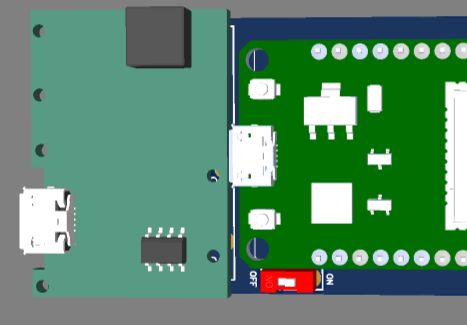 Ongoing
OngoingInmp_441Esp32
STDInmp_441Esp32
License
:TAPR Open Hardware License
Description
## Project Overview
This project involves designing a PCB to record sound using the INMP441 microphone with an ESP32 microcontroller. The recorded sounds will be sent to a server for storage and analysis. The PCB includes a J5019 18650 Li-ion battery charger, one push button, and two LED indicators.
### Key Features:
- **Sound Recording:** Using the INMP441 MEMS microphone.
- **Wi-Fi Connectivity:** Using the ESP32 module to send data to a server.
- **Battery Powered:** Integrated J5019 charger for a 18650 Li-ion battery.
- **User Interface:** One push button and two LED indicators.
---
## Components
### Main Components:
1. **ESP32-WROOM-32**: A powerful Wi-Fi and Bluetooth-enabled microcontroller.
2. **INMP441**: A high-performance, low-power, omnidirectional MEMS microphone.
3. **J5019 Charger Module**: A lithium-ion battery charger for 18650 batteries.
4. **18650 Li-ion Battery**: A rechargeable lithium-ion battery.
5. **Push Button**: For user input.
6. **LED Indicators**: For status indication (red and green LEDs).
### Additional Components:
- Capacitors and resistors for power stabilization and signal conditioning.
- Headers for programming and debugging.
- Connectors for the battery and microphone.
---
## Schematics
### Schematic Overview:
The schematic is divided into several parts: power supply, ESP32, microphone interface, user interface, and connectors.
1. **Power Supply Section**:
- **J5019 Module**: Connect the battery to the input terminals of the J5019 module.
- **Battery Connection**: Connect the 18650 battery to the output terminals, providing power to the PCB.
- **Voltage Regulator**: A voltage regulator to provide stable 3.3V to the ESP32.
2. **ESP32 Section**:
- **Power Supply**: Connect the ESP32's VCC to 3.3V.
- **GPIO Connections**: Connect the GPIO pins for the microphone, LEDs, and button.
3. **Microphone Interface**:
- **INMP441**: Connect the VCC to 3.3V, GND to ground, SCK to ESP32 GPIO18, and SD to GPIO19.
4. **User Interface**:
- **Push Button**: Connect one side to GPIO23 and the other to ground.
- **LED Indicators**: Connect the anodes of the LEDs to GPIO21 (red) and GPIO22 (green), with appropriate current-limiting resistors to ground.
### Schematic Diagram:

---
## PCB Layout
### Design Considerations:
- **Component Placement**: Place the ESP32 module centrally for easy access to pins and minimal signal path lengths.
- **Power Traces**: Ensure thick traces for power lines to handle the current without significant voltage drop.
- **Signal Integrity**: Keep signal traces short and minimize crossing over power traces.
- **Ground Plane**: Use a continuous ground plane to reduce noise and improve signal quality.
### PCB Layout Image:

---
## Firmware Development
### Development Environment:
- **IDE**: Use Arduino IDE or PlatformIO.
- **Libraries**: Install necessary libraries for Wi-Fi (ESPAsyncWebServer), I2S (ESP32 I2S Library), and HTTP (HTTPClient).
### Code Overview:
1. **Setup**:
- Initialize Wi-Fi, I2S, and GPIOs.
- Configure LEDs and button as input/output.
2. **Loop**:
- Continuously read audio data from INMP441.
- On button press, start recording and send data to the server.
- Use LEDs to indicate recording status and error states.
3. **Data Transmission**:
- Package audio data in HTTP requests.
- Handle server responses and retries.
```cpp
#include <WiFi.h>
#include <HTTPClient.h>
#include <driver/i2s.h>
#define I2S_WS 18
#define I2S_SD 19
#define I2S_SCK 5
#define BUTTON_PIN 23
#define LED_RED_PIN 21
#define LED_GREEN_PIN 22
const char* ssid = "your_SSID";
const char* password = "your_PASSWORD";
const char* serverURL = "http://your_server_address/record";
void setup() {
// Initialize Serial
Serial.begin(115200);
// Initialize WiFi
WiFi.begin(ssid, password);
while (WiFi.status() != WL_CONNECTED) {
delay(500);
Serial.print(".");
}
Serial.println("Connected to WiFi");
// Initialize I2S
i2s_config_t i2s_config = {
.mode = i2s_mode_t(I2S_MODE_MASTER | I2S_MODE_RX),
.sample_rate = 16000,
.bits_per_sample = i2s_bits_per_sample_t(I2S_BITS_PER_SAMPLE_16BIT),
.channel_format = I2S_CHANNEL_FMT_ONLY_RIGHT,
.communication_format = i2s_comm_format_t(I2S_COMM_FORMAT_I2S),
.intr_alloc_flags = ESP_INTR_FLAG_LEVEL1,
.dma_buf_count = 8,
.dma_buf_len = 64
};
i2s_driver_install(I2S_NUM_0, &i2s_config, 0, NULL);
i2s_pin_config_t pin_config = {
.bck_io_num = I2S_SCK,
.ws_io_num = I2S_WS,
.data_out_num = -1,
.data_in_num = I2S_SD
};
i2s_set_pin(I2S_NUM_0, &pin_config);
// Initialize GPIO
pinMode(BUTTON_PIN, INPUT);
pinMode(LED_RED_PIN, OUTPUT);
pinMode(LED_GREEN_PIN, OUTPUT);
}
void loop() {
if (digitalRead(BUTTON_PIN) == LOW) {
digitalWrite(LED_GREEN_PIN, HIGH);
recordAndSendAudio();
digitalWrite(LED_GREEN_PIN, LOW);
}
}
void recordAndSendAudio() {
const int bufferSize = 1024;
int16_t buffer[bufferSize];
size_t bytesRead;
i2s_read(I2S_NUM_0, &buffer, bufferSize, &bytesRead, portMAX_DELAY);
HTTPClient http;
http.begin(serverURL);
http.addHeader("Content-Type", "audio/wav");
int httpResponseCode = http.POST((uint8_t*)buffer, bytesRead);
if (httpResponseCode > 0) {
Serial.printf("Server response: %d\n", httpResponseCode);
} else {
Serial.printf("Error: %s\n", http.errorToString(httpResponseCode).c_str());
}
http.end();
}
```
---
## Server Setup
### Requirements:
- A server with a web server (e.g., Apache, Nginx).
- PHP or Python for handling file uploads.
- Storage for audio files.
### Server Script Example (Python):
```python
from flask import Flask, request
app = Flask(__name__)
@app.route('/record', methods=['POST'])
def record_audio():
if 'file' not in request.files:
return "No file part", 400
file = request.files['file']
if file.filename == '':
return "No selected file", 400
file.save(f"./uploads/{file.filename}")
return "File uploaded successfully", 200
if __name__ == '__main__':
app.run(debug=True, host='0.0.0.0', port=80)
```
### Deployment:
- Upload the script to your server.
- Ensure the server is accessible via the ESP32's network.
---
## Assembly Instructions
### Steps:
1. **Solder Components**:
- Solder ESP32, J5019, and other components onto the PCB.
- Use appropriate soldering techniques for SMD components if applicable.
2. **Mount Battery**:
- Securely mount the 18650 battery and connect to the charger module.
3. **Connect Microphone**:
- Connect the INMP441 module to the designated header.
4. **Install Firmware**:
- Use an FTDI adapter or other programmer to upload the firmware to the ESP32.
5. **Test Connections**:
- Verify all connections and check for shorts or loose connections.
---
## Testing and Troubleshooting
### Initial Testing:
- **Power On**: Ensure the PCB powers up from the battery.
- **Wi-Fi Connection**: Check if the ESP32 connects to Wi-Fi.
- **Button and LED**: Press the button and verify LED response.
### Troubleshooting:
- **No Power**: Check battery voltage and connections.
- **Wi-Fi Issues**: Verify SSID and password, check Wi-Fi signal strength.
- **Audio Issues**: Ensure correct I2S configuration and connections.
Design Drawing
 The preview image was not generated, please save it again in the editor.
The preview image was not generated, please save it again in the editor.BOM
 Bom empty
Bom empty Clone
CloneProject Members
 Empty
Empty


Comment